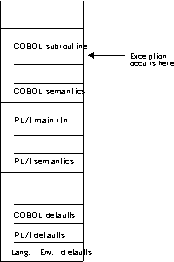Exception occurs in COBOL
This scenario describes the behavior of an application that contains a COBOL and a PL/I routine. Refer to Figure 1 throughout the following discussion. In this scenario, a PL/I main routine invokes a COBOL subroutine. An exception occurs in the COBOL subroutine.

The actions taken follow the three Language Environment condition handling steps: enablement, condition, and termination imminent.
- In the enablement step, COBOL determines
whether the exception that occurred should be handled as a condition.
- If the exception is to be ignored, control is returned to the next sequential instruction after where the exception occurred.
- If the exception is to be enabled and processed as a condition, the condition handling step takes place.
- If a user-written condition handler has been registered using
CEEHDLR on the COBOL stack
frame, it is given control.
If it issues a resume, the condition handling step ends. Processing continues in the routine to which the resume cursor points.
Two areas to watch out for here are resuming from an IBM® condition of severity 2 or greater (see the information about coding a user-written condition handler in z/OS Language Environment Programming Guide) and moving the resume cursor in an application that contains a COBOL program (see GOTO out-of-block and move resume cursor).
In this example, no user-written condition handler is registered for the condition, so the condition is percolated.
- Is a user-written condition handler has been registered on the PL/I stack frame using CEEHDLR, it is given control. If it issues a resume, the condition handling step ends. Processing continues in the routine at the point where the resume cursor points. In this example, no user-written condition handler is registered for the condition, so the condition is percolated.
- If an ON-unit has been established for the condition being processed on the PL/I stack frame, it is given control. If it issues a GOTO out-of-block, the condition handling step ends. Execution resumes at the label of the GOTO. In this example, no ON-unit is established for the condition, so the condition is percolated.
- After all stack frames have been visited, and if the condition is COBOL-specific (with a facility ID of IGZ), the COBOL default action occurs. Otherwise, the Language Environment default actions take place.
- What happens next depends on whether the condition is promotable
to the PL/I ERROR
condition. The following can happen:
- If the condition is not promotable to the PL/I ERROR condition, then the Language Environment default actions take place, as described in Table 1. Condition handling ends.
- If the PL/I default action for the condition is to promote it to the PL/I ERROR condition, The condition is promoted, and another pass of the stack is made to look for ERROR ON-units or user-written condition handlers. If an ERROR ON-unit or user-written condition handler is found, it is invoked.
- If either of the following occurs:
- An ERROR ON-unit or user-written condition handler is found, but it does not issue a GOTO out of block or similar construct
- No ERROR ON-unit or user-written condition handler is found
- If no condition handler moves the resume cursor and issues a resume, Language Environment terminates the thread.